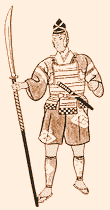
|
|
After the Onin War,
the power of the Muromachi shogunate fell
leaving daimyo fighting with each other for territory and power. The
values of bushido appeared forgotten as many
warriors fought against their own lords. The period is noted for the
aspirations of three Sengoku-Daimyo ('great warlords'),
who as well as being neighbours along the Tokaido
road were usually at war with each other. They each played an important
part in the unification of Japan.

Oda Nobunaga (1534-1582), was the first
to exercise this vision which would finally bring an end to the chaos
of civil war. He was a daimyo of Taira
descent and ruled the Oda in the province of Owari. His power grew
as he defeated his opposition. In 1568 Nobunaga took control of the
capital city of Kyoto and five years later succeeded in driving out
the last of the Ashikaga shoguns. By 1580, his control extended over
all of central Japan but before he could realise his dream of unification,
he was assassinated by one of his own generals.
Nobunaga's successor was Toyotomi Hideyoshi
(1536-1598), his most able general. Hideyoshi, continued the effort
to unify Japan and became Dajo-Dajin 'Grand Chancellor'
in 1586. He was aided by Tokugawa Ieyasu, and together they defeated
the daimyo of Kyushu and Shikoku and by 1590 Japan was unified under
Hideyoshi's dictatorship. Order had finally been established and new
boundaries were marked out for feudal fiefs. He retired in 1592 and
later named his five year old son to be his heir. A 'council of regents'
were appointed to support the young Hideyori,
and manage government.
Now came, Tokugawa Ieyasu (1542-1616),
a descendant of the Minamoto clan. He had
fought against the Oda but later joined Hideyoshi and became one of
the 'council of regents'. In 1599, Ieyasu moved into Osaka Castle
to assume the role of guardian to Hideyori.
The government was not wholly united and some resented Ieyasu, notably
Ishida Mitsunari.
Charges were made against Ieyasu, whose response was a declaration
of war which led, in 1600, to one of the greatest battles in Japanese
history: The Battle of Sekigahara |
Mitsunari lead the 'loyalist' Western army against
Ieyasu's Eastern army. An estimated 200,000 warriors fought and against
the odds, due to keen strategy and some bribery, Ieyasu won the day.
This decisive battle gave Ieyasu the ultimate prize, complete control
of Japan and the beginning of the 'Tokugawa Shogunate'. |
|


